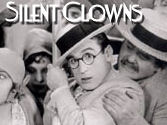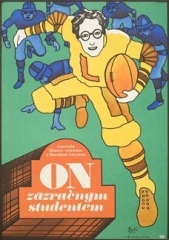 |
HAROLD LLOYDSAFETY LAST By Matt Barry |
Matt Barry is a film enthusiast, film maker and film historian. His contributions to our site are always welcome.
 With Safety Last, Harold
Lloyd scaled the heights of the
artistic possibilities of the silent film medium,
and gave silent comedy perhaps its most iconic moment: that of the
bespectacled, straw-hatted go-getter hanging from the side of a
skyscraper on the second-hand of a large clock, dangling over a busy
street.
With Safety Last, Harold
Lloyd scaled the heights of the
artistic possibilities of the silent film medium,
and gave silent comedy perhaps its most iconic moment: that of the
bespectacled, straw-hatted go-getter hanging from the side of a
skyscraper on the second-hand of a large clock, dangling over a busy
street.
Lloyd made better films than
Safety Last: The
Kid Brother
is probably the strongest from a narrative standpoint; The Freshman
provides a stronger character arc; and it would be hard to top Why
Worry? for sheer number of clever gags. But what makes Safety Last, and
especially its “human fly” sequence, so iconic is precisely the fact
that it demonstrates the art of silent comedy that was so totally
unique to the medium.
Lloyd got the idea for the building
climb when he
observed a “human fly” scaling the side of a building in Los Angeles.
He recruited that climber, Bill Strother, to act in the film. Lloyd had
worked in “thrill comedy” before, most notably in his short films High
and Dizzy (1920) and Never Weaken (1921), the latter with its memorable
sequence in which Harold, believing he has successfully committed
suicide, is lifted up on his office chair and out through the window by
a girder beam on a crane. As he believes he is ascending to Heaven, he
gets a rude awakening when he looks down to see the city streets below
him! Although “thrill comedy” wasn’t new to Lloyd, he would take it to
new heights in Safety Last.
In many ways, the plot of Safety Last
seems to exist
solely as a means of getting Harold up on that building. The plot is
set up in the opening scene, when Harold’s girlfriend (played by
Lloyd’s wife and long-time leading lady, Mildred Davis) tells him to go
to the city and make good. He finds work as a department store clerk,
and, desperate to climb the ladder of success, pitches a publicity
stunt in which a “human fly” (played by Bill Strother) will scale the
side of the department store. Complications ensue on the big day, when
Strother is forced to flee from a policeman, and Lloyd is forced to
climb the building himself.
Much has been written about the lengths
to which
Lloyd went to achieve the effect of being as high up on that building
as he appears to be. Walter Kerr, in The
Silent Clowns,
notes that the building itself was located on a hill which, when
combined with the careful placement of the camera, gave the illusion of
a being at a much steeper angle than it actually was. Additionally,
Lloyd placed a mattress below him in order to break his fall should he
drop.1 Regardless of the means used to create
the illusion,
and the precautions taken to lessen the risk, Lloyd really demonstrates
his incredible physical abilities in this sequence, displaying an
astonishing degree of creativity in finding new ways to keep the
audience in suspense as he scales the building. Despite the length of
the sequence - more than a third of the film’s running time 2
- it never grows dull or repetitive. In This is Orson Welles, Welles
said of Safety Last’s “human fly” sequence: “As a piece of comic
architecture, it’s impeccable. Feydeau never topped it for sheer
construction.”3
The climb is a perfectly structured
piece of comic
filmmaking. In Film as Art, Rudolf Arnheim writes about selective
camera placement as an example of “how the various peculiarities of
film material can be, and have been, used to achieve artistic effects.”4
In this respect, Safety Last is an excellent example of the artistic
effects made possible by the placement of the camera in heightening the
effects of thrills and danger that are so essential to the comedy.
 The opening sequence of the film gives another example of this
technique at work. We first see Harold in close-up, standing behind
bars. In the background is a noose, and a uniformed official stands
near him. We then see his girlfriend saying goodbye to him, with tears
in her eyes. The viewer assumes that Harold is in prison, about to be
led to his execution. However, the next shot-a wide shot-reveals that
Harold is merely waiting at the gate of a train station; the uniformed
official merely a conductor; the noose a mail catcher, and so on. Aside
from serving as a bit of dark humor, it also provides another example
of the kind of tricks Lloyd played on the audience by selectively
showing only parts of the entire scene. This cinematic deception also
hints at the character deception that Harold must engage in throughout
the film: hiding with his roommate in coats hanging on the back of a
door in their apartment in order to dodge the landlord; posing as the
store manager to impress his girlfriend when she makes a surprise visit
to see him at work; and of course, being forced to play the part of a
“human fly” in order to save his job at the department store. In
addition to the suspense provided in the building climb sequence, there
is also a great deal of suspense in wondering how long Harold will be
able to pull off his charade in posing as the department store manager.
Lloyd seems to be commenting on the dizzying heights of success to
which his character is expected to climb, and the illusion, based on
deception, that could be shattered at any moment.
The opening sequence of the film gives another example of this
technique at work. We first see Harold in close-up, standing behind
bars. In the background is a noose, and a uniformed official stands
near him. We then see his girlfriend saying goodbye to him, with tears
in her eyes. The viewer assumes that Harold is in prison, about to be
led to his execution. However, the next shot-a wide shot-reveals that
Harold is merely waiting at the gate of a train station; the uniformed
official merely a conductor; the noose a mail catcher, and so on. Aside
from serving as a bit of dark humor, it also provides another example
of the kind of tricks Lloyd played on the audience by selectively
showing only parts of the entire scene. This cinematic deception also
hints at the character deception that Harold must engage in throughout
the film: hiding with his roommate in coats hanging on the back of a
door in their apartment in order to dodge the landlord; posing as the
store manager to impress his girlfriend when she makes a surprise visit
to see him at work; and of course, being forced to play the part of a
“human fly” in order to save his job at the department store. In
addition to the suspense provided in the building climb sequence, there
is also a great deal of suspense in wondering how long Harold will be
able to pull off his charade in posing as the department store manager.
Lloyd seems to be commenting on the dizzying heights of success to
which his character is expected to climb, and the illusion, based on
deception, that could be shattered at any moment.
Safety Last was the second-to-last film
Lloyd made
with producer Hal Roach, whom he’d been working with virtually ever
since they entered films together in the early 1910s. They parted ways
in 1923, with Lloyd setting up his own independent production for
release through Pathe (and later Paramount). “Thrill” comedy would
remain a part of Lloyd’s work, but he developed his craft toward an
increasingly character-oriented approach that would culminate in films
like The Freshman and The Kid Brother. The memorable chase sequences in
Girl Shy, For Heaven’s Sake and Speedy, not to mention the exciting
fight in the hold of a ship in The Kid Brother, are examples of the
“thrill” element he never totally abandoned. He would never again
create a “thrill” sequence as effective, thrilling and funny as the
building climb from Safety Last, however. His attempt in his second
talkie, Feet First, pales in comparison, partly because the situation
lacks the narrative drive of the earlier film, and also because the
addition of sound subtracts from the overall experience, emphasizing
the danger Harold is in and diminishing the comedy. In his final screen
appearance, in Preston Sturges’ The Sin of Harold Diddlebock (1947),
Harold once again finds himself on the ledge of a tall building, except
this time the “thrill” effect is totally neutered by the fact that he’s
clearly in front of a process screen.
Safety Last remains one of Lloyd’s most
popular
films; its image of Harold hanging from the clock has been copied and
imitated, but never equaled. A masterpiece of comic construction,
driven by a strong, logical flow of gags, character and narrative, it
is a perfect representation of the art of silent
comedy.
Endnotes:
1. Walter Kerr, The Silent Clowns.
(New York: Alfred A. Knopf, 1975), 198.
2. Joe Franklin, Classics of the
Silent Screen. (Seacaucus, NJ: The Citadel Press, 1959), 44.
3. Orson Welles, quoted in Jonathan
Rosenbaum, ed. This is Orson Welles. (Cambridge, MA: DaCapo Press,
1998), 38.
4. Rudolf Arnheim, Film as Art.
(London: Faber and Faber Ltd., 1958), 38.
Copyright © Matt Barry, 2010. All Rights Reserved. Used by Special Permission.


